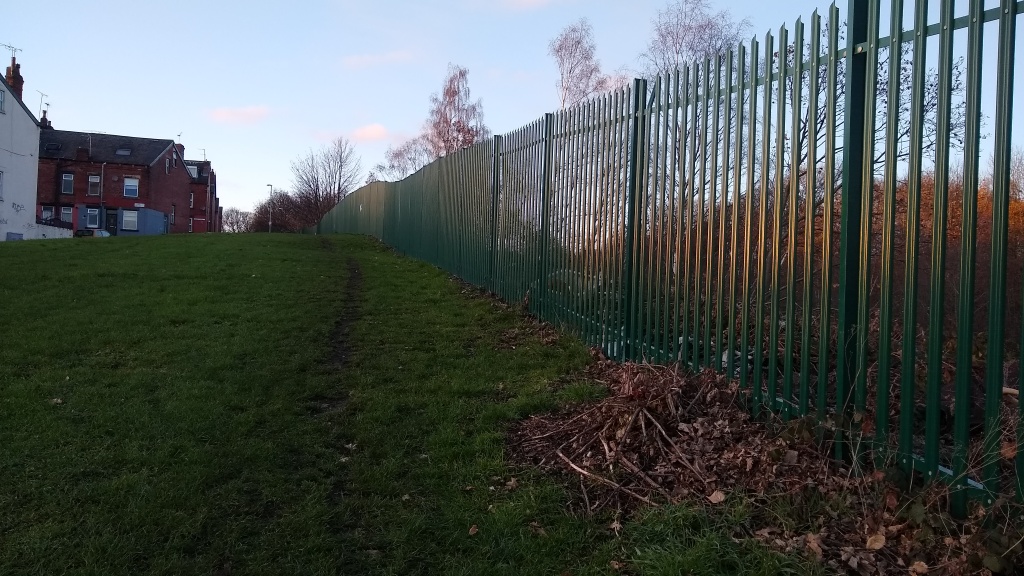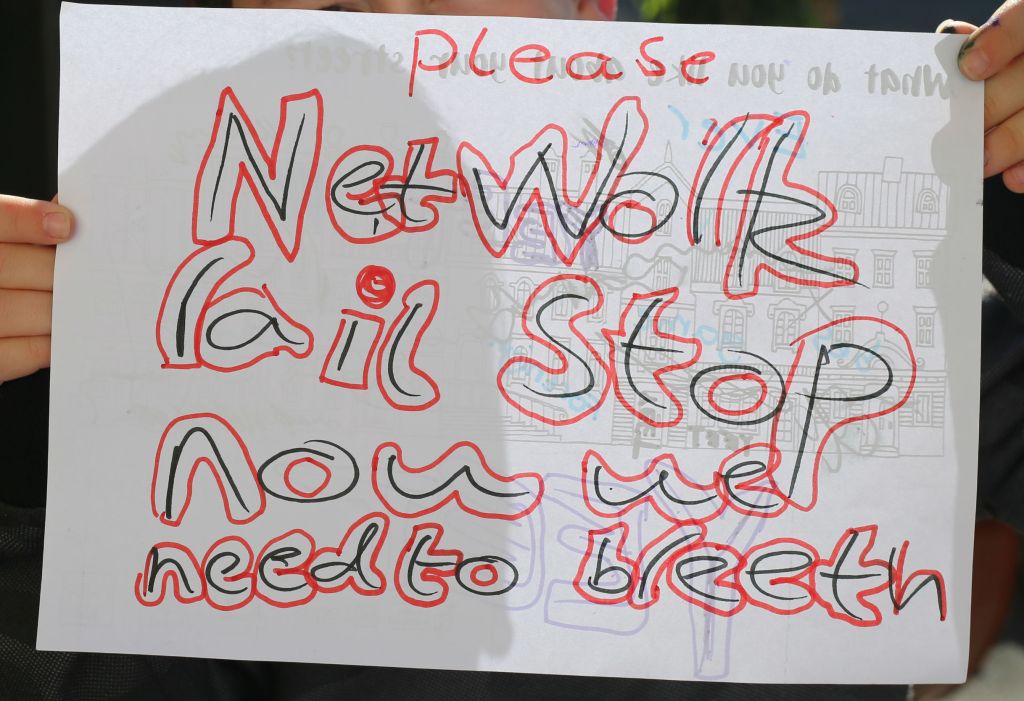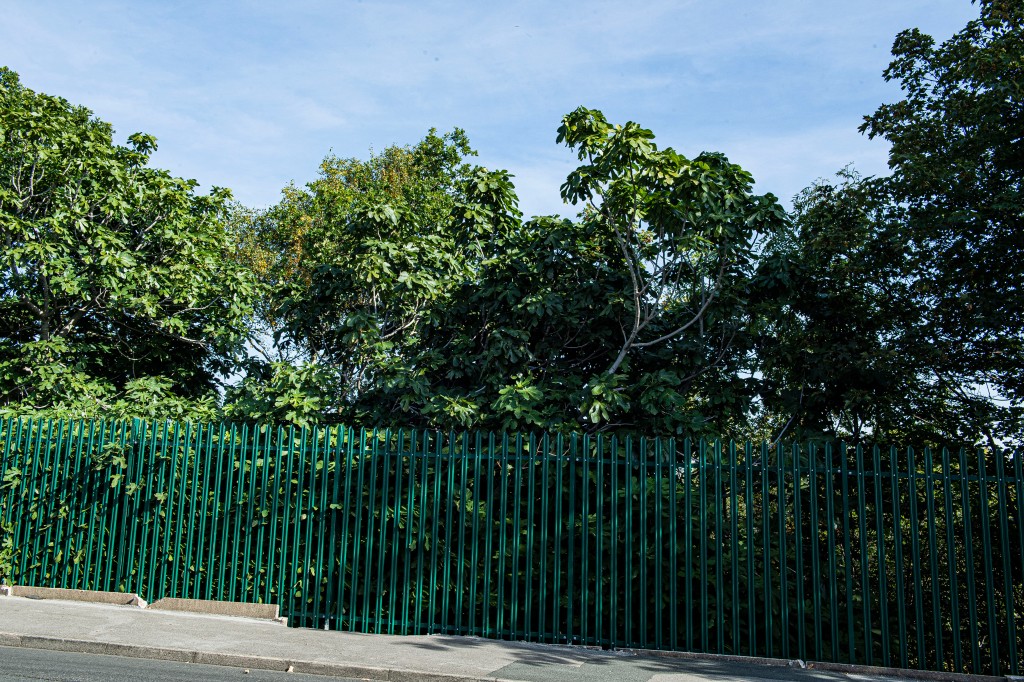The Armley Trees campaign has been set up in response to Network Rail cutting down trees on the railway cutting next to Armley Park Road and Armley Park woods. In a guest post for WLD, the group writes about its aims for the future…
Having lived next to the trees and wildlife in the railway corridor adjacent to the Aviaries estate in Armley for many years, it’s understandable that local residents have a deep attachment to this part of their community and see them as ‘their’ trees.
For many residents, the trees have been there all their lives. Left to grow by Network Rail and their predecessor Railtrack, and neglected for decades, the trees, vegetation and wildlife are an established feature of Armley Park Road – bringing a raft of benefits to people (such as to their mental and physical health) and the environment. The benefits of trees are well documented and earlier in the year we posted this report on the importance of Armley’s trees (written for us by the United Bank of Carbon (UBoC) at the University of Leeds).
Our estate is one of the most deprived areas in the country according to the Index of Multiple Deprivation (IMD).
Most of the houses are back-to-backs and have no gardens. Subsequently the trees, vegetation and wildlife in the railway cutting provide welcome green space and create a vibrant, living wildlife corridor with a high level of health and amenity value to local people.
The trees also help to manage climate change through carbon capture and sequestration, remove pollution from the atmosphere, act as a sound barrier for the railway and help with avoided run off associated with rainfall.
Residents living right next to the railway cutting enjoy bird song on a daily basis, and are uplifted by the sounds of owls at night and the familiar flutterings of bats as they use the line of trees at the top of the cutting as a foraging route.
The wider area is host to a range of protected species such as otters (and lets not forget the bats). The railway cutting is right next to Armley woods and Armley & Gotts Park (a Registered Park and Garden) and the Leeds and Liverpool Canal. It also forms part of a crucial pollinator route that runs right through Leeds. The importance of this urban green infrastructure cannot be downplayed.
So it’s easy to see why the thought of losing this well-established beautiful inner city oasis in the blink of an eye (under the cover of darkness and to the sound of a cacophony of chainsaws) is upsetting for many local people – particularly as an upcoming programme of tree felling by Network Rail is about to start without the wider community and other key stakeholders having been meaningfully engaged in the process.

Chainsaw carnage
Many local residents are still traumatised by having to helplessly stand and watch a line of healthy, mature trees next to the green on Armley Park Road being felled in front of them and thrown into chipping machines in the middle of the day in September 2019.
This work was carried out by Network Rail’s contractors, with no notification having been given to the local community, leaving behind a very different barren scene dominated by Network Rail’s high green security fence.
A large section of land close to where the railway crosses the canal had also been clear felled in the middle of the night some weeks earlier, with only a small number of houses on the estate having received any information about it (apparently via letters randomly pushed through a handful of doors by contractors).
It soon became clear to local people that the tree felling on Armley Park Road was a part of a wider programme of work to remove every single tree from the railway cutting, with various conflicting reasons given. What was noticeable was that no safety surveys had taken place to back up such a wide-scale project and no apparent consideration had been given to what impact it might have on the biodiversity of the railway cutting, the environment or the lives of local people living right next to it.
Work on a section of the railway cutting further into Leeds opposite Farnell reduced the bank to bare earth with one pollarded tree left at the top – described by one Ward Councillor as looking like a scene from no-man’s land in World War One.

‘Vegetation management’
In the absence of any accessible information about the work on Network Rail’s website – and alarmed by reports in the Guardian about their indiscriminate ‘vegetation management’ practices across the country and descriptions of what happened at Hadley Wood in 2018 – local residents stood up for the trees, the environment and their community and began to take action. Complaints and concerns made to Network Rail’s ‘helpline’ were largely ignored (some to this day have not received a response).
It took the persistence of local people (with the support of Armley Ward Councillors and our MP Rachel Reeves) campaigning and writing letters for the programme of work to be put on hold the following week.
The Tree Council were asked to undertake a review of the scale of the work and suggest how a different approach could be taken and, in December, a tree safety survey was undertaken by Network Rail’s contractors.

Commitment to ‘do things differently’
On the face of it, it looked like things were going to be done differently in Armley, with Network Rail promising to reassess the scale of the ‘vegetation management’, look to alternative solutions to clear-felling whilst also safely managing the railway cutting, and fully engage the community in a meaningful two-way process before finalising the scope of the work.
Recommendations from the Valuing Nature review of Network Rail’s vegetation management (commissioned by the Department of Transport and undertaken by John Varley in 2018) were to be at the core of a shared way forward, to ensure that the importance of biodiversity and environment would be embedded alongside safety and performance.
A series of meetings took place (chaired by the Executive Board Member for Climate Change, Transport and Sustainable Development) with the aim of working in partnership with key stakeholders, including the Armley Trees campaign group and Leeds Councillors.
However, Network Rail walked away from the discussions, with the next communication about the revised programme for the revised tree felling work being in mid-September to tell us it was about to start.
Other factors have not helped, including how communication around the felling of four trees at the start of bird nesting season was handled and Network Rail repeatedly changing their ‘single point of contact’.
One year on and in some ways it would appear that little has changed, with Network Rail still intending to clear fell a large proportion of the railway cutting (and potentially kill the roots of some of the trees) – without having meaningfully engaged in the agreed two-way process with residents and other key stakeholders.
The clear commitments to engage the wider community in the early stages, listen to and take on board their concerns and suggestions, and involve them in the planning of an ‘evidence based’ programme of work, came to nothing.
Now, in October 2020, many local people are again finding themselves unclear as to what might be lost from the railway corridor in the darkness of night and how the issues around biodiversity, environment and community have been taken on board.
Last month, residents received a notification letter referring to a finalised programme of fly tipping removal and tree felling. The letter gave little in terms of specific detail or certainty about the full nature and scale of the work (in part because some of the trees require further inspection). The timescale was given as being from October to Spring, with the potential for some work to take place over Christmas.
The letter included details of a ‘telephone conference call event’ to be held on 24 September for lineside neighbours to find out about the fly tipping removal and tree felling work. Many residents on the Aviaries estate received this letter after the event had taken place. Those that did receive a letter in time could not participate in the call as an access code was required, details of which were not included in the letter.
The promises to create a dedicated web page for residents to see the full information about the work, including the tree report, have not materialised.

Red and yellow lines
Now the sight of red and yellow markings appearing overnight on some of the trees over recent weeks with no visible indication on site as to what that might mean has left some residents perplexed and even anxious about what is going to happen next – and further kept in the dark regarding the extent of tree felling soon to take place.
What is not clear to anyone standing on Armley Park Road is that the bottom 2/3 of the railway cutting will be completely clear felled, and they would be forgiven for thinking that the scale of the work is fairly minimal.
There are positives, of course. Had the work continued unchallenged a year ago then the railway cutting would now be completely devoid of trees and vegetation. We are told some mature trees will remain, in addition to our amazing, much loved fig trees which the community specifically fought for one year ago.
However, the fate of many of the trees has yet to be decided so the final number remaining could be as few as 15 along the length of Armley Park Road and Armley Park (with only one remaining opposite Farnell). As you can imagine, we want to do what we can to ensure that as many trees as possible can be retained in some way, shape or form whilst ensuring the safety of the railway.

Safety
The safety of the railway is important to us and in no way are we as a group saying that it should be compromised. However, we believe a balance needs to be made and alternatives to clear felling used where possible to ensure that biodiversity and environment are embedded alongside safety and performance, with efforts made to conserve biodiversity where possible.
The impacts on local communities should also be taken on board, including the health and safety benefits that trees offer to humans as can be seen here in research undertaken in 2015. Being around trees has positive effects on health and wellbeing and there is evidence that simply seeing them can reduce stress, lower blood pressure and improve mood. Additionally, a recent study found that growing up in a greener urban environment boosts children’s intelligence and lowers levels of difficult behaviour.
Network Rail’s emphasis is currently on offsetting loss rather than looking to conserve biodiversity, and any evidence regarding concern for the environment or the lives of lineside neighbours on the estate has so far been lacking.

Alternative solutions
We believe that the alternative solutions mentioned to us earlier in the year at various meetings need to be given weight to save trees and vegetation where it would be safe to do so; it was promised that things would be ‘done differently’ this time and that ways to retain trees rather than clear-felling them would be considered.
For example, we have seen trees listed for felling on the basis that they are of ‘limited long term value’. Of limited value to whom exactly and why? The value of some of the trees due to be felled, in terms of the wider benefits to health, amenity, the environment, and as cultural & social assets, do not appear to have been considered in any of the reports – and to remove them would not necessarily benefit either the safety of the railway or the local community perched at the top of the railway cutting.
This is exactly the kind of thing we were promised to have the opportunity to engage with and challenge, yet now Network Rail say this discussion is closed. The only thing they have told us that they are prepared to engage the community with is planting more trees and offsetting biodiversity. Whilst this is important, particularly where some of this could happen locally in the limited space available, the priority for us is currently preserving biodiversity and as many trees as possible.
There are examples of this kind of approach of using ’alternative solutions’ on other parts of the railway network. One such example is Sonning Cutting where it was agreed that a significant number of mature oaks would be pollarded rather than clear felled (cited in the Valuing Nature report).
It was also agreed at Sonning that wood from trees would not be chipped but left onsite in a safe place. In the context of the Leeds declared Climate Emergency, we would like to see wood from any trees felled by Network Rail here in Armley being used for furniture or building materials, or for benches in the restored habitats, so that the carbon stored in the wood is retained (as an alternative to putting trees in chipping machines).

We are still asking for a meaningful discussion to take place between Network Rail, our community, elected representatives and other key stakeholders regarding the full extent of the work and the report concerned with tree safety and engineering works – as per promises made that we would have the opportunity to discuss, understand and question decisions made on a tree-by-tree basis.
It appears to us that Network Rail underestimates the concern that our community has for safety and it does at times feel that they are patronising us instead of committing to engaging us in intelligent discussion.
We are waiting for a number of other reports to be provided, so we can see how Network Rail have fully considered and embedded biodiversity and environment alongside safety and performance.
We are asking Network Rail to be open, honest and transparent with the wider community and our elected representatives by providing full, relevant information about the work so we can all have clarity about what is going to happen and when.
Tree felling work and further fly tipping removal is now due to start overnight on the weekend of 31 October/1 November.
We have written to Network Rail to ask that the work is put on hold until the issues have been resolved, concerns addressed, questions answered, information provided and the community given the opportunity to engage with the plans in a meaningful two-way process – with the aim of creating long term lasting partnerships based on trust and mutual respect.

